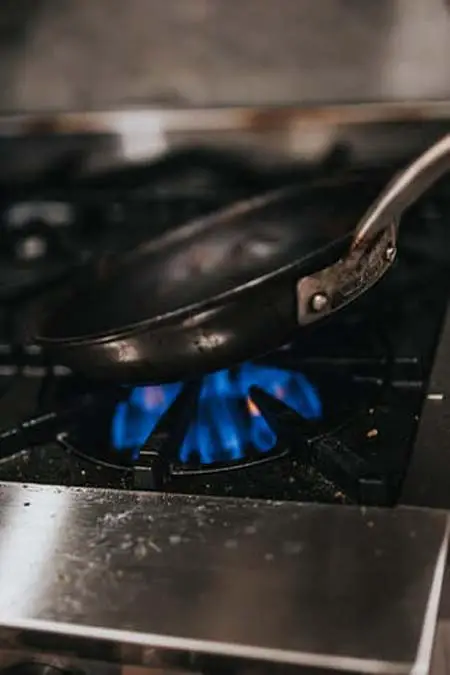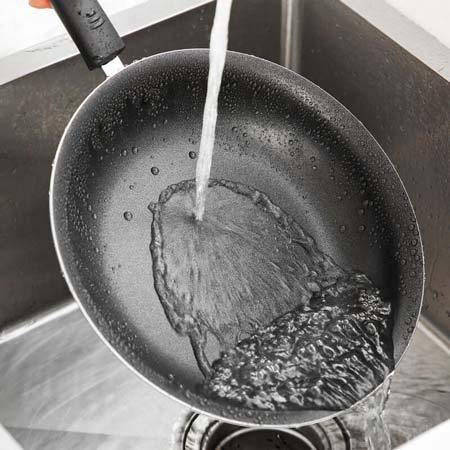If you’ve ever owned ceramic nonstick cookware, you know how great it can be. I think most of us like cooking our morning eggs on ceramic pans.
But, what about when it turns brown or, despite its nonstick status, food keeps getting stuck to it? Do you need to season ceramic pans? And if so, how do you treat ceramic pans?
You can probably figure out that our answer is yes. We’ve got a whole post about it after all!
In this article, we’ll answer all those questions plus more. We’ll walk you through exactly how you can season your nonstick ceramic frying pan and enjoy your cookware to the fullest!
In a rush? Click here to skip ahead to “How to Season a Ceramic Pan.”
Otherwise keep reading for valuable knowledge on all things nonstick ceramic.
Ceramic Nonstick Cookware: What You Need to Know
Let’s dive right in!
The most important things to keep in mind about your favorite nonstick ceramic cookware are:
Also take a look at: What You Should Know About Hard Anodized Aluminum Vs Ceramic Cookware.
Ceramic Nonstick Cookware: Which to Buy?
When in the market for new ceramic nonstick cookware, first take a look at your budget.
How much are you willing to spend? Do you want cookware that will last the longest or are you okay settling for cheaper even if it burns out quicker?
Performance-proven cookware. Their signature raised circles lead to better total nonstick and food release. Some of their products are even nonstick on the exterior, making cleanup hassle-free (like their lifetime warranties!). With one of their ceramic nonstick pans, you can mix up a delicious breakfast of shakshuka without the headache of a sticky, eggy mess to wash up afterward.
Founded in 1963, Calphalon is known for producing premium-quality cookware for home kitchens and professional settings both. The founder is credited with actually inventing the hard-anodized style cookware back in the ‘60s that other companies now use as well. With nonstick cookware that’s more durable, warp and corrosion-resistant, we can all enjoy longevity from our kitchen helpers. Looking for a new vegetarian breakfast option? Check out their recipe for kale, avocado, sweet potato breakfast burritos!
While this company is best known for its food processors, they do so much more. Cuisinart cookware is high-quality, built to last. You can tell by the number of lifetime warranties that come with their products. You’ll be able to tackle any cooking task with grace and ease if you have a Cuisinart nonstick ceramic pan in your hands. What should you make next? So glad you asked! Try this lightened-up version of Spaghetti Bolognese, it uses squash to cut down on calories from carbs!
These revolutionary cookware makers have been crafting metals since the 1940s. In the 1980s, they changed the scene with their own hard-anodized nonstick cookware lines. Hard-anodized stands apart from the rest because it’s nonstick that doesn’t scratch or flake off like other coatings. Though you do need to treat it with care. They’re nonstick on the interior and the exterior, as well as being dishwasher-safe. Their large saucepans are perfect for whipping up a batch of mashed potatoes for the extended family! (That recipe also recommends using a food processor, if you don’t have one check out our article on What is the Best Substitute for a Food Processor.)
This producer of popular nonstick cookware pots and pans wants you to succeed in your culinary adventures. T-Fal wants to make nonstick cookware accessible to every family seeking greater connection and health in the kitchen. They believe cooking at home should be both attractive and simple. Make your everyday life easier with their Thermo-spot heat indicator cookware line. Want to get fancy for your friends? Why not make this gourmet starter of pan-fried asparagus with strawberries, balsamic vinegar, and grilled bacon!
We have several helpful reviews to guide you to make the absolute best purchase for you and your home kitchen. By reading them first, it’s almost like you get to “try before you buy!”
Other than your budget, you need cookware that fits your style, stovetop, and needs. Wondering why you even need different sized saucepans?
We’ve got you covered once again. Check out: Why Do You Need Different Sized Saucepans? [3 Important Reasons].
Ask yourself how the set will look in your kitchen (aesthetics are important!), how many people it will feed, and always take a look at the warranty as well.
Read How to Buy the Best Cookware for Your Money to get started!
How Do You Season a Ceramic Nonstick Pan?
First, check to see if your cookware is oven safe. If no, skip this first method.
Oven-Safe Seasoning Method
This method is highly recommended for ceramic bakeware.
Brush your pan with cooking oil (depending on the size of your cookware you may need 1 teaspoon to 1 Tablespoon). Allow it to preheat in the oven to 250 degrees Fahrenheit.
Cool completely before using it for cooking. Do not wash with soap immediately after seasoning.
Oven-Less Seasoning Method
If you’re unsure if your cookware is oven-safe, definitely go for this stovetop method!

Directions:
- 1Start with a clean pan* by washing with soap and water.
- 2Rinse, then dry completely.
- 3Use a paper towel or your fingers to coat the pan with oil (don’t use olive oil or butter as neither has a high smoking point)
- 4Place your prepared pan on your stovetop over medium heat.
- 5Wait until it begins to smoke. It will take a while, let it heat slowly.
- 6If your stovetop surface is uneven be sure to turn the pan to prevent the oil pooling in one spot.
- 7As soon as it smokes, remove from heat.
- 8Allow the ceramic pan to cool completely.
- 9When it is once again room temperature, use a paper towel to wipe out any excess oil.
- 10Do not wash again until after cooking in it.
Check out our FAQ section to learn how often you should repeat this process.
*Even if your ceramic pan is brand new, it’s very important that you wash it first!
You may also like: How to Tell the One Big Difference Between a Pot Vs a Pan.
FAQs
The following are some frequently asked questions regarding the care and cleaning of ceramic nonstick cookware. Whether your pan has changed color on you or you want to know if a specific product is okay to use, it’s all answered down below!
How Often Should You Season Your Nonstick Ceramic Pan?
You should always season your pans before you use them for the first time. And if it is brand new, season it every month or two for the first few months after unboxing.
Otherwise, your ceramic cookware only needs treating about twice a year.
Not bad, right?
Mark your calendar maybe once in the spring for cleaning and again before winter hits.
White Ceramic Pan Turned Brown?
Have you ever watched your beautiful white ceramic pan turn brown after a few uses?
It’s discouraging! And why does it happen?
Often it’s because food is cooked at too high of a temperature and it burns on. But never fear — you can get your white pans back!
Keep reading to learn how.
How to Clean Ceramic Pan?
Here’s a full walkthrough on cleaning a nonstick ceramic pan. Follow these careful instructions to minimize damaging your nonstick cookware. Keep your favorite kitchen tools healthy and feeding you tasty meals for years to come!

Gather Your Supplies
Step-By-Step
- 1Fill your sink (or a large dishpan) with warm water and a few squirts of liquid soap.
- 2Submerge the dirty pan and scrub with soft sponge or cloth.
- 3Rinse thoroughly with clear, warm water.
- 4Dry with a dishtowel (or allow to air dry).
How to Remove Stuck-On Food with Baking Soda
For stubborn food particles, let your pan soak in the warm, soapy water for a while first.
When you come back to scrub it, apply baking soda to your damp sponge. Or sprinkle baking soda directly on the pan.
Scrub. Rinse well. Dry.
Apply Hydrogen Peroxide to Treat Discoloration
First aid strength (3%) hydrogen peroxide that you pick up at the grocery store is all you need to restore brilliant color to your white ceramic coating. Hydrogen peroxide offers a slight bleaching action.
Before you use this method, check if your bottle of hydrogen peroxide is still good.
Pour enough to cover the bottom. Let it sit for at least 30 minutes before you rinse it out.
Enjoy your like-new ceramic cookware!
How to Clean with Vinegar
Not much cleans like the power of vinegar. Dilute about ¼ cup vinegar with a ¼ cup water in your dirty saucepot.
Add two Tablespoons of baking soda. Bring to a boil on your stovetop. Then turn the heat down to low/simmer it for about 10 minutes.
Allow the liquid and the pot to cool down before you drain it. Wash, rinse, and dry normally.
Having trouble controlling your eating habits?
Take a look at our article on How to Stop Food Cravings When You’re Not Hungry
Can You Use Bar Keepers Friend on Ceramic Cookware?
Bar Keepers Friend is a great choice of product for cleaning your ceramic cookware. Not only will it clean your pans, but it will also polish them.
Shine on, nonstick ceramic pots!
Conclusion
Now you know how to shop for ceramic nonstick cookware, how to season it, and even how to clean it. You’re basically a pro on all things ceramic — kitchen-wise anyway!
Wondering what meal to create in your nonstick ceramic cookware next?
Try one of our recipes! We’ve got healthy options to choose from like chicken, fish, and veggies.
And of course, don’t forget about dessert! The whole family will love these Strawberry French Macarons.
Comment below with a recipe you’d like to see on our blog or if you have any other questions about ceramic cookware.
Last update on 2025-06-30 / Affiliate links / Images from Amazon Product Advertising API


